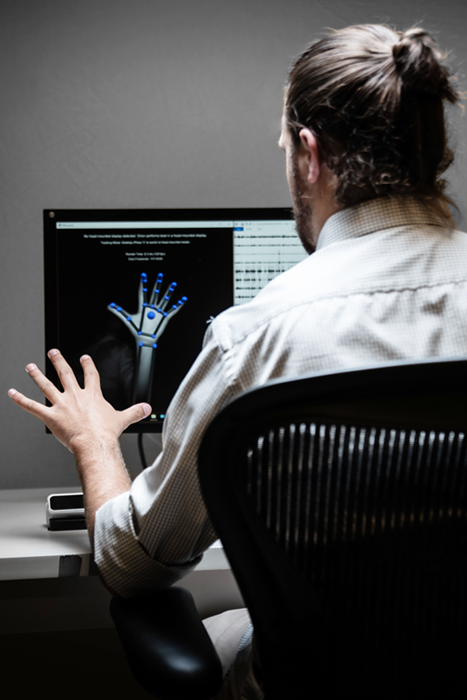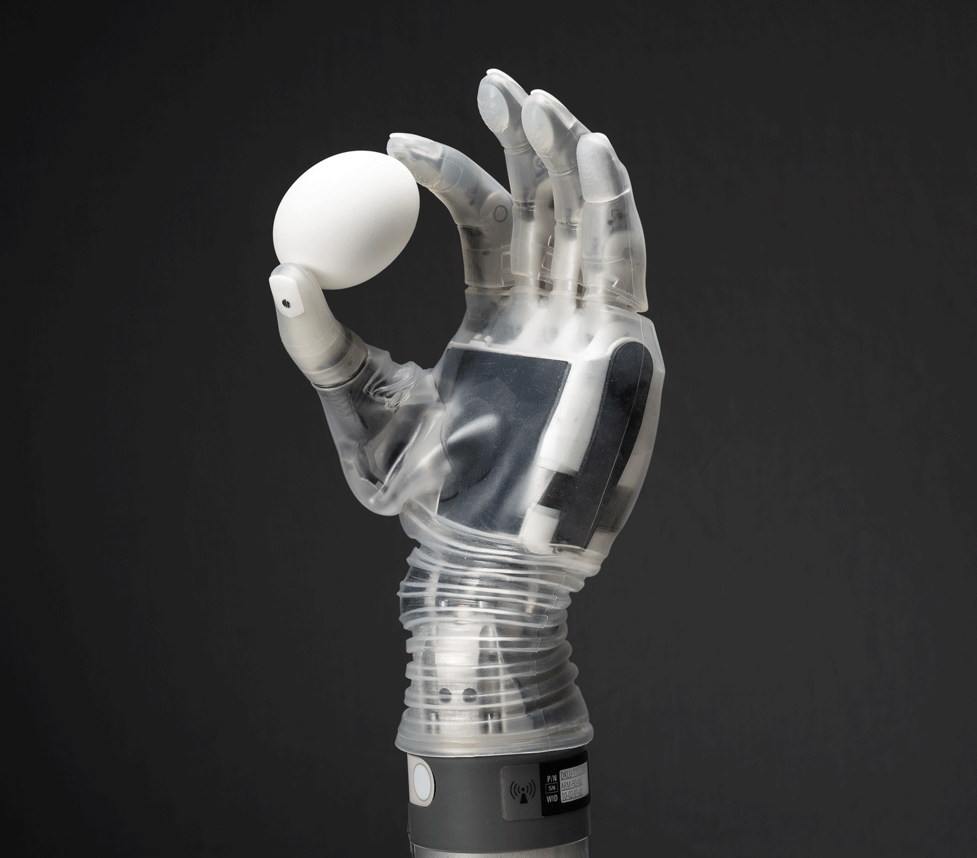In the shadows of his North Salt Lake garage, Matthew Beckstead uses the ends of his arms to cradle the conduit pipe that almost killed him. These aren’t stumps, he says. “A stump is the end of a tree. I call them my arms.” He points with his chin to the grooves in the metal. “Here’s where my fingers melted into the pipe,” he says. Beckstead was just 19 when he lost his arms below the elbow in 1998 while working on a billboard in Ogden. He was holding the conduit pipe he now keeps as a souvenir when an illegal power line sent 27,000 volts through his hands. He fell in flames to the ground, only for the impact to restart his heart.
The double amputee says he had to reteach himself how to put on his socks, bathe, go to the bathroom, and make food, as well as how to fish, hunt, mow the lawn, and care for his wife and three children. Despite his relentless pursuit of self-sufficiency, the dream of one day getting his hands back, as opposed to using the most up-to-date commercial prosthetics currently languishing in his closet, remained just a dream.

That is until 2016, when he took part in tests led by Gregory Clark, associate professor of biomedical engineering at the University of Utah’s College of Engineering. These tests seek to electrically connect the user’s remaining arm nerves and muscles to a sophisticated artificial arm called Life Under Kinetic Evolution, or LUKE. Made by DEKA Research & Development Corporation, the arm is named after Luke Skywalker, who lost a hand in a light saber duel in the Star Wars classic The Empire Strikes Back. U emeritus professor of biomedical engineering Richard Normann and colleagues have developed a neural interface called the Utah Slanted Electrode Array (USEA) that functionally joins the volunteer’s severed nerve ending to the LUKE arm.
“Our job is to connect the arm to the person so they can move it just by thinking about it,” Clark says. And by communicating back a sense of touch and movement, he notes, the limb feels real. In essence, their brain tells them they have their arm back.
The U’s multidisciplinary team—drawing on neuroengineers, materials scientists, electrical and computer engineers, surgeons, and rehabilitation specialists—has been pushing the boundaries of the relationship between human and technology under the umbrella of the Department of Defense-funded program Hand Proprioception and Touch Interfaces (HAPTIX), with additional support from the National Science Foundation.
Beckstead was the fourth of seven volunteers, all amputees. After U hand surgeon Douglas “Hutch” Hutchinson implanted two USEAs, each with 100-point electrodes, into Beckstead’s nerves, researchers hooked him up to a computer to see if he could manipulate a virtual hand with his mind. While lab technicians busied themselves, Beckstead thought about bending his pinkie, then his thumb, then his finger, only for the screen hand to respond to his thoughts. One of the technicians looked over his shoulder, wide-eyed. “Is that you?”
The resultant hullabaloo among Clark’s team made Beckstead marvel at never having seen so many people get so excited in all his life. “I was the first person in the world to control the hand they’re working on, on the screen,” he says, with the same passion and pride similarly expressed by the other volunteers who have helped turn the Skywalker arm from prosthesis to dexterous hand.
"THEIR BRAIN TELLS THEM THEY HAVE THEIR ARM BACK."
THE GIFT OF ONESELF
Losing a hand is akin to losing a family member, one volunteer told Clark. “Emotionally, to get back the sense that their hand is actually alive again—which is something we can begin to do—is very, very meaningful to them,” Clark says.
“If we can give them some sensation, then they start to feel it’s theirs and they’ll use it,” adds Hutchinson.
With each volunteer, each piece of the puzzle, Clark and his team get ever closer to reuniting people with, in some senses at least, their own hand, although it’s far more than that. “I want people to have their sense of self restored, to feel whole again,” Clark says.
In 2015, the U received the first part of a $4.8 million federal grant that funded the most recent round of testing, carrying the neural interface program from virtual reality to volunteers testing a wireless arm both in the lab and on campus grounds. The involvement of U amputation rehabilitation specialist Christopher Duncan focused in part on “taking them from basic science, watching a computerized hand on a screen moving through a range of motions, to real space.” He began by printing 3-D open-source hands and implanting sensors that meant volunteers could start to control the prosthetics with their thoughts. These accomplishments were a bridge to the LUKE hand, says Clark. The team has high hopes for the impact of the HAPTIX program. Duncan recalls how one double-amputee hadn’t felt anything with his hands in 20 years.
The volunteer had withdrawn from society to a nocturnal life of video games, which he played with his toes. But as he spent more time at the lab, “we saw him blossom,” says Duncan. “He was positively ecstatic he could feel things.”
HOLDING HANDS
As Keven Walgamott talks about the accident that claimed his left hand, he repeatedly massages the end of his arm where the hand was amputated. The Twin Falls, Idaho-born realtor was pulling a submersible pump out of a 20-foot well on his property when an arc of electricity from overhead high voltage lines struck his pole as he raised it. The electricity went in through his left hand, through his body, blew half his left foot off, and knocked him unconscious.
His prosthetist recommended him for Clark’s studies. “I thought it would be helpful if they could improve the prosthesis,” Walgamott says. “I don’t wear one now because it’s so impractical.”
After Hutchinson implanted several arrays of electrodes into the nerves and muscles in his forearm that help control the hand and wrist, Walgamott underwent tests in Clark’s lab. His amputated left arm was hidden on one side of a small barricade, but he was able to control one of Duncan’s 3-D printed hands, which was in front of him.
Once the experiments for the day concluded, Suzanne Wendleken, a student researcher, asked Walgamott if there was anything he’d like to do. “I’d like to clasp my hands together,” he said.
Clark’s ears pricked up. Not clasp the prosthetic—but “my hands.” Walgamott reached out with his intact biological hand and gripped the prosthetic. “I really felt like it was my hand,” he recalls. “For a split second, it was remarkable to be able to clasp hands again.” In the second half of Walgamott’s 14 months with the lab, the team brought in the LUKE arm and conducted the tests all over again, but this time with the more advanced LUKE arm electrically connected to Walgamott’s motor and sensory systems. He was the first person to try the sensorized LUKE arm this way. “Not only did it move, but I felt things when I touched them, too. I hadn’t felt anything on my hand in 12 years,” he says. Walgamott turned to his wife, and she took his left hand—his LUKE hand—and shook it. Perhaps more than any other volunteer, he highlighted that “what you do when you love somebody, you touch them,” adds Duncan.

ON THE CHOPPING BLOCK
Perry Pezzarossi’s contribution to HAPTIX began in late August 2017, when his primary doctor in Louisiana referred him to U of U Health to find an answer to the chronic pain in his right hand. For many years, since shattering his wrist in 1993 on active service, he had been forced to live with excruciating pain. He faced one solution, albeit not one he wanted to act on: amputation. Pezzarossi met with Clark, and the researchers connected the LUKE arm to him.
His wife handed a ball to the LUKE hand, and Pezzarossi tossed it back to her with his thoughts—even though his biological hand couldn’t move because of his shattered wrist. “That’s it,” he said. “Chop and swap. I’m in.” Because he lived out of state, U researchers hadn’t been considering Pezzarossi as a possible test subject. In addition, unlike the six previous volunteers who had lost their hands a decade or more before their involvement, Pezzarossi still had to go through the removal of his damaged hand before he could participate. “If I prevent one person going through what I have, then I win,” he says.
Hutchinson amputated Pezzarossi’s right hand to help reduce his chronic pain and make it possible to attach a conventional prosthetic arm. He implanted three electrode arrays in Pezzarossi’s arm nerves and 32 electrodes in his remaining forearm muscles. Pezzarossi’s long disuse of his broken, twisted hand, its aberrant movements (called dystonia), and arm-muscle atrophy all raised questions for the research team about how soon he would be able to control the arm post-surgery. They needn’t have worried. “He was very successful, right off the bat,” Clark says, controlling up to 16 different flexion and extension movements of a virtual arm.
"I FELT THINGS WHEN I TOUCHED THEM. I HADN’T FELT ANYTHING ON MY HAND IN 12 YEARS."

Ultimately, “Perry was able to accomplish multiple sophisticated activities of daily living both inside and outside the lab.” Three months post- surgery, Pezzarossi started wearing the LUKE arm, quickly learning he’d have to retrain his brain to use it. “It doesn’t feel like this feels,” he says, holding up his left hand. “I had to learn what the new feeling was going to be. It’s tough, it’s great, but it’s not easy.” In total, Pezzarossi had implants for a record 17 months, the first of the volunteers to use the LUKE arm beyond the lab’s confines. When he tested the hand under supervision outside the campus lab, he said,“I’m thinking ‘OK, it’s real, it can really happen. I’m proving right now it can be done.’ ”
While Clark and his team await approval from the U.S. Food and Drug Administration to begin testing a new wireless version of the program that would allow volunteers to take the LUKE arm home, those who’ve helped to bring HAPTIX to this point inevitably wonder what their life would be like if they had their own LUKE arm. Like many others, Walgamott says he doubted a dexterous prosthetic arm would be accessible in his lifetime and hoped at least future amputees would benefit. But when he got to briefly test the arm in the lab, he did things he hadn’t been able to do for years, such as pulling on a pillowcase and hammering a nail. He marvels,“These things are closer than I ever knew they were.”
Then he expressed something Pezzarossi and Beckstead also wanted passed along. “If they need another volunteer, please contact me again.”
About the author: Stephen Dark is a writer for University of Utah Health.



1972, 1973, 1974, onwards, as a grad student and principal accident reconstructionist for the Utah Auto Crash Research Team, I had a Biomedical Engineering minor. And I participated in the development of the Utah Arm with Dr. Steve Jacobsen, RIP. It was for amputees above the elbow and picked up the nerve signals. It used small motors to provide the 3 degrees of freedom required. And No mention of it. Whatever happened to it? And, whatever happened to the hybrid vehicle developed by my first boss, Prof. Fred Wagner? We were ahead of the times, but now forgotten? Thank you.
Steve Jacobsen was a true genius. That’s not a label I often apply, but in this case it’s deserved.
Our multidisciplinary work builds on Jacobsen’s contributions, and on many others’, both in the past and ongoing. Key other multiple contributors include local neurotechnology companies Ripple Neuro LLC, which makes many of the electronics, and Blackrock Microsystems, which makes the USEA nerve interfaces, as well as scientific and engineering collaborators at the University of Chicago, Cleveland Clinic, MuJoCo, the FDA, and others, including of course DEKA, which makes the LUKE arm.
As is common for the lay press, the article is not meant to be comprehensive description of the biomedical engineering as a whole or even this particular study. Instead, it tries to capture the public’s imagination via a focused, intimate story.
Steve is not forgotten. His legacy and memory continue in many ways. And some members of his team have been been important collaborators in this project, and others.
That said, the field has advanced since (and because of) the pioneering contributions of Jacobsen and colleagues. The LUKE arm has more degrees-of-freedom (types of movements), and has sensors as well as motors. The U’s task has been to connect the arm to the user’s own neuromuscular system, Luke-Skywalker style, so that the user can move the arm in a realistic, biomimetic, intuitive way, and can control each joint simultaneously in real time (using proportional control, rather than a nominal classifier). Because of the hundreds of electrodes implanted in the remaining arm nerves, we can also provide biologically realistic sensory feedback from the arm so that the user can feel the senses of touch and of movement (proprioception), and, ideally, begin to feel whole again
This is an amazing work in progress! This brings hope now and in the very near future to many individuals in our world who are so much in need of this technology.
It is my hope that funding and bureaucratic red tape will not hinder the amazing work of our researchers. Please keep up the great work you are doing to make a difference in our world!
Thank you for your encouragement. Seeing what our participants can accomplish and experience has been our strongest motivator.
Regulations can be frustrating both to researchers and to potential users, who want to benefit from technology now because their needs are now.
However, overall, such regulations are often necessary and even helpful. Without them, shoddy products and unsafe devices would invade the marketplace and exploit people who are desperate for a solution. History prior to the FDA tells us this is so.
Funding is always an issue. But every person deserves a good life. That’s why we’re a civilization, not just 7 billion independent individuals.
At the present time, these research programs, advanced devices, and technologies are prohibitively expensive for almost any one person. That’s true for almost any high-tech product in the early stages. Consider computers. Once (not long ago) they were multi-million-dollar devices obtainable only by advanced research centers. Now almost all of us walk around with powerful computers (cell phones) in our product at nominal cost.
Progress feeds further progress.
Would the Luke Arm work for someone who was born without a hand? My father has Symbrachydactyly of the left hand.
Yes, in many ways. We are already doing so, in early-phase studies, with some success.
The commercial version of the LUKE arm (which is different from the version we are using, and in how we are using it), is controlled remotely by motion detection units worn on the feet. That approach would probably work for your father.
What our research team does is different, but would probably also work for your father.
We capture electrical control signals from the user’s own body, Luke-Skywalker style. Some electrical signals that we use come from muscles. That may seem strange. How can you capture signals from hand muscles if someone doesn’t even have a hand? The answer is that many hand muscles actually are not in the hand, but are instead in the forearm. Hence these muscles can remain even if someone does not have a hand (either because of traumatic injury, or because of irregular development).
Likewise, we also capture signals from (listen to) or send signals (talk to) motor or sensory nerve fibers. Perhaps surprisingly, those nerve fibers also keep working even after the hand is gone, and also are often present in the case of developmental abnormalities.
I am a right wrist dis-articulation individual. I have a bebionic 3 hand and I use it far more than any other prosthetic. I would love to participate in any way as your research and development progresses. I live in the Salt Lake valley.
stanlindaas@stanlindaas.com
Thank you for your interest and willingness.
I will contact you at your email directly, and will put you in touch with our human subjects team.
Please be advised that this research is in the early stages, and the present number of participants is few. However, we hope to continue and to expand the overall effort into the future.
Please make a partial hand!
Yes, partial hands are an important problem. Although the Utah team isn’t directly making such partial hands, other teams are doing so. Importantly, much of what Utah has developed and discovered applies to these challenges as well.
As a reminder, Utah doesn’t make the LUKE arm. Instead, Utah’s role is to attach the LUKE arm (made by DEKA) to the user’s own neuromuscular system. That way, the user can move the arm just by thinking about it, and can receive sensory information back from the arm, transmitted to the sensory nerve fibers.
One point is this: These very same techniques could be used to control a partial prosthetic hand, or to receive sensory feedback from one. We could still capture motor signals and send them to a partial prosthetic hand; and we could still receive sensor information back from the prosthesis, and translate that into a biomimetic digital pulse code to send up the sensory nerve fibers from the hand to the brain.
Another point: Other research teams outside of Utah are working directly on solutions to partial-hand amputations. The way to tackle a big set of problems is to break them down into smaller, more manageable chunks. Utah communicates with these other teams regularly.
Utah is focusing on amputations between the elbow and wrist–for amputations that involve the complete loss of hand, but below the elbow. Partial-hand amputations and above-elbow amputations (where the hand muscles in the forearm are also gone) pose related but somewhat different challenges. Overall, it’s beneficial to have different teams coming up with specialized solutions for specialized problems. But for the parts of the problems that do overlap–and there are many–progress by one team facilitates progress by the other teams.
Wow, this is such an amazing and inspiring story! I admire Matthew Beckstead’s courage and determination to overcome his challenges and live a full life. I also think the research done by Gregory Clark and his team is incredible and groundbreaking. They are giving hope and opportunity to people who have lost their limbs. I can’t wait to see how the LUKE arm and the USEA interface will change the lives of many more people in the future. This is truly a remarkable example of human resilience and innovation.